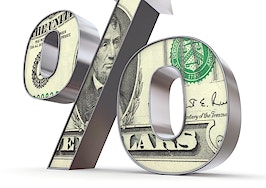In the last 24 hours long-term rates have pulled back from the brink of panic. The first leg down came as thinking replaced short-selling: The Fed does not want to abort the mini-maybe-recovery under way. The second leg came overnight with safety buying after the U.S. announced it will intervene in Syria.
Somebody today with perfect credit and 40 percent down might get a no-point mortgage below 4 percent, but the 10-year T-note still sits at 2.11 percent, halfway between max-panic 2.27 percent and the 1.95 percent when Fed Chair Ben Bernanke scared everyone to death on May 22.
This interest rate volatility has little to do with economic data. Maybe nothing.
May retail sales crept up 0.6 percent, and industrial production was flat after two-straight monthly declines. The NFIB survey of small business had one of its best readings during the Great Recession, but not a breakout. For the time being, assume that all confidence surveys are boosted by better housing markets, although those are still not remotely sufficient to pull the economy into a normal recovery.
A lot is going on under the surface of Bernanke’s “taper.”
A term common to Fed-watching prior to the Bernanke era — “jawbone” — had been lost in his faculty-club collegial cacophony.
Bernanke’s predecessors carefully crafted the few policy words spoken in public, and thus they had great power. Ninety-nine percent of Fed speeches and papers were nothing more than obtuse filler, intentionally confusing.
Bernanke has tried to run a transparent show. All are allowed to speak. Most old-timers think the children should not hear everything that parents say to each other.
I am certain that the chairman knew what he was doing on May 22, swinging the old-fashioned jawbone to hint at a minuscule policy change at some indefinite point ahead, but I suspect that he has been surprised by the magnitude of effect.
The taper tantrum since has made some sense, but in most respects makes no sense at all. The Fed’s overnight cost of money remains near zero and will stay there open-ended until clear, self-sustaining recovery, which makes it very lucrative to hold long Treasurys with leverage even at low yields.
The Fed has made it clear that it intends to continue to buy Treasurys and mortgage-backed securities (MBS), and even when it stops has no intention to sell them. In the case of MBS, the Fed may hold all until they pay off.
So, where’s the fire? Carry the jawbone thought forward.
Central banks have the ability to change the course of markets and whole economies just by talking, doing nothing, and the foundation of that power is a confidence game.
Example: Ten months ago the European Central Bank announced outright monetary transactions (OMTs), the direct buying of European sovereign debt in any quantity necessary to hold down costs of borrowing. Long rates there fell almost in half and have stayed down, although Europe is in worse shape every day, and sovereign defaults are more likely than ever.
However, the European Central Bank’s OMT announcement has not bought a single euro’s worth of anybody’s bonds. It has been a pure, defiant con game. It works so long as the European Central Bank makes it look suicidal to trade against it. Bernanke in QEs 1-2-3 was running the same con, but on May 22 invited the world to trade against him.
He may have a very hard time reinstating the con. The entire purpose of QE (“quantitative easing” — purchases of Treasuries and MBS) and zero percent short-term rates (the federal funds overnight rate) — has been to keep down long-term rates to secure recovery. Long-term rates now are rising all over the world while the global economy slows, exactly the opposite of proper market function.
Not just the Fed is exposed: All central banks are at risk. They can buy time, but cannot simultaneously stimulate and withdraw.
Several people raised voices this week to point out the obvious: If every sovereign is desperately selling paper to avoid “austerity,” and central banks are not going to buy (except too-far-gone Japan), and global banks are overregulated, capital-pinched, proprietary trading shut down by Volcker rules, unable to buy or finance others … then who is going to buy?
There is a silver lining. Ultimately all economies must reform and rationalize. Might have to get on with that, starting with a conclusion to the bubble overreaction.
Lou Barnes is a mortgage broker and nationally syndicated columnist based in Boulder, Colo. He can be reached at lbarnes@pmglending.com.








